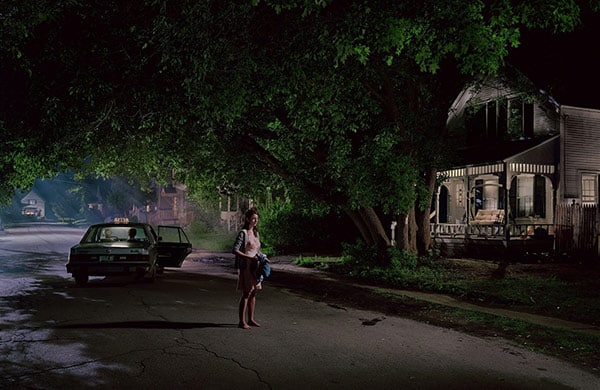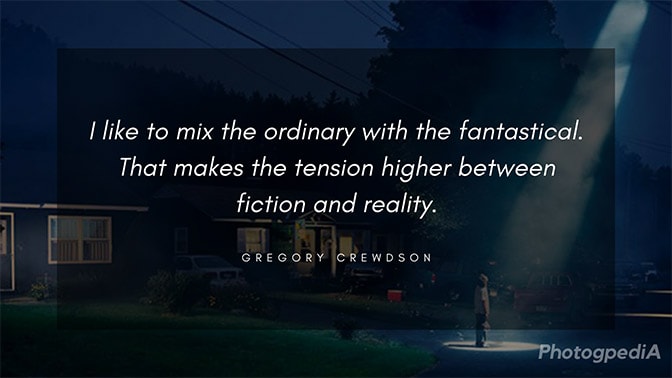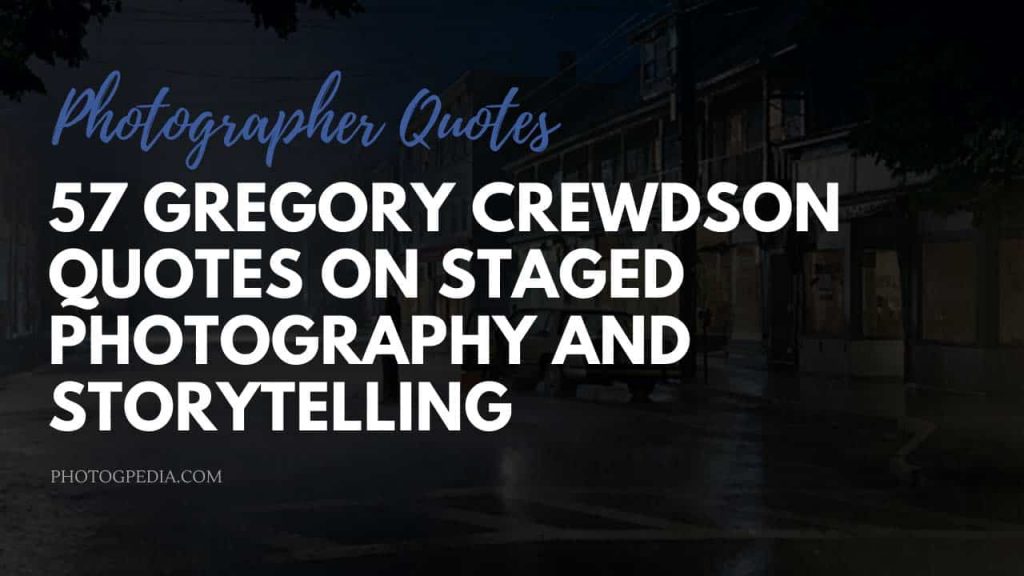If you’re on the hunt for the best Gregory Crewdson quotes, then you’ve come to the right place. Below are 57 quotes from one of the masters of conceptual photography.
If you would like to learn more about Crewdson’s staged photography and working methods, then check out our Gregory Crewdson master profile article.
Gregory Crewdson Quotes
Photography is a lonely endeavor, and I think all photographers are in one way or another drawn to the medium by kind of an alienated viewpoint.
I think that, in a sense, there’s something about photography in general that we could associate with memory, or the past, or childhood.
In this age of Instagram, and pictures on cell phones, and social media, it’s a real challenge to think of the photograph still meaning something important.
I do think that dread is about a certain kind of expectation. And the fact that a picture can never resolve itself the way a movie can – maybe that’s a specific kind of dread that becomes associated with a picture.
There isn’t a picture that was ever made that doesn’t speak about mortality in some way.
I’m not that particularly talented in terms of making anything or – I’m not technically efficient. I certainly don’t know how to draw very well or paint, and I’m not good with computers. But I think the thing that I’m good at is willing something into life, no matter what. I do what it takes to get it done.
All pictures are autobiographical, yet they’re telling us everything and nothing about the photographer.
Originally, one of the reasons I was drawn to photography, as opposed to painting or sculpture or installation, is that of all the arts it is the most democratic, in so far as it’s instantly readable and accessible to our culture. Photography is how we move information back and forth.
If my pictures are about anything at all, I think it’s about trying to make a connection in the world. I see them as more optimistic in a certain way. Even though it’s very clear there’s a level of sadness and disconnection, I think that they’re really about trying to make a connection and almost the impossibility of doing so.
Nobody on this Earth is going to make these pictures aside from yourself. So if you don’t do it, no one else will.

Quotes on Story and Narrative
Every artist has a central story to tell, and the difficulty, the impossible task, is trying to present that story in pictures.
What the artist attempts to do is to try and tell a story. Attempting to give physical expression to a story that’s internal.
What I’m after, what I’ve always been after is a picture that tells a story. I see it all in my head beforehand, and I set out obsessively – maybe even narcissistically – to make it. Very little is improvised in the end, though I am open to serendipity in some details. In part I see what I am doing as exploring the American psyche through the American vernacular landscape, much as Hopper did.
I’m interested in the question of narrative, how photography is distinct from, but connected to, other narrative forms like writing and film. This idea of creating a moment that’s frozen and mute, that perhaps ultimately asks more questions than it answers, proposes an open-ended and ambiguous narrative that allows the viewer to, in a sense, complete it.
Since a photograph is frozen and mute, since there is no before and after, I don’t want there to be a conscious awareness of any kind of literal narrative. And that’s why I really try not to pump up motivation or plot or anything like that.
For all the talk of my pictures being narratives or that they’re about storytelling, there’s really very little actually happening in the pictures. One of the few things I always tell people in my pictures is that I want less – give me something less.
I never know what to call the subjects in my pictures because I’m uncomfortable with the word actor. I think maybe subjects might be more accurate – or maybe even more accurate is objects.
I have always been fascinated by the poetic condition of twilight. By its transformative quality. Its power of turning the ordinary into something magical and otherworldly. My wish is for the narrative in the pictures to work within that circumstance. It is that sense of in-between-ness that interests me.
As artists we walk around with a single story to tell, some kind of central narrative. And I think the struggle is to attempt to reinvent that story over and over again in different forms and to visualize that story through, in my case, photographs, and try to make it new each time.
The viewer is more likely to project their own narrative onto the picture.
Capturing the Moment
My pictures are moments after the moment between moments really, and I think twilight is a beautiful metaphor for that. In “Twilight,” the narratives are more literal, and the event is much more spectacular. The pictures in “Beneath the Roses” are much more psychological and grounded in reality.
The whole reason I make these pictures is for those moments of clarity. For that single moment, everything seems to make sense in my world. And I think we all look for that in our lives, because our lives are generally filled with chaos and confusion and disorder and complication.
I’m only concerned with that particular moment, the moment of the picture. I really don’t have any interest in what happens before, or what happens after. In a certain way, it’s a privilege that I don’t have to think about plot, or storyline, or character development, that I can just focus on that moment, and how to make that moment as beautiful and as mysterious as possible.
We print these images in large format at this size because it’s like… Well to me it’s like a picture window.
I want to privilege the moment.
You have this ambition to make something perfect, exactly right. Of course, necessarily, it fails in some way and you have to accept that for what it is, and then you’re on to the next thing.
What I am interested in is that moment of transcendence, where one is transported into another place, into a perfect, still world.
My pictures are about a search for a moment – a perfect moment. To me the most powerful moment in the whole process is when everything comes together and there is that perfect, beautiful, still moment. And for that instant, my life makes sense.

Ambiguity and Mystery
I’m interested in this ambiguous moment that draws the viewer in through photographic beauty, through repulsion, through some kind of tension.
I’m very moved by the fact that people are drawn into the pictures and that they do bring their own history and their own interpretation to the photograph. I think that’s why they work in a certain way.
My first impulse is to make the most beautiful picture I can. But then I’m always interested in this idea of a kind of undercurrent in the work… I’m very interested in the uncanny and a way to find something mysterious or terrible within everyday life.
My pictures must first be beautiful, but that beauty is not enough. I strive to convey an underlying edge of anxiety, of isolation, of fear.
I think all my pictures are psychologically rooted. There’s not much on the surface that is direct narration. Whatever story is being told should remain a mystery – a question mark even to myself. I’m more interested in telling the submerged narrative using light, colour, atmosphere and mood.
The photograph is still and frozen. From day one, I have been interested in taking that limitation and trying to find the strength in it – like a story that is forever frozen in between moments, before and after, and always left as a kind of unresolved question.
My father was a psycho-analyst and I think that fact was very influential on my development as an artist. Trying to search beneath the surface of things for an unexpected sense of mystery.
All my pictures are very voyeuristic, but ultimately I’m looking at what lurks in my own interior. I make photographs because I want to answer the question of what propels me to do the things that I do. But that always remains a mystery.
Design, Locations and Lighting
I was never conscious of filming except for when I was location scouting. In a way, that is the most important part of the entire process – and the most private. I’m so used to doing that alone. Unlike every other part, it’s just me, alone, on location. It’s very hard to describe what I’m looking for – something that feels both familiar and strange at the same time. It’s not enough for it just to be strange or mysterious, it also has to feel very ordinary, very familiar, and very nondescript.
Usually I’ll drive to certain locations over and over again, over a course of months really. And then it might just be I hit it at the right time, and the right light. And then I might go to that location over and over again, and then what happens in that lag time where – the image sort of locks in – all of a sudden I see it in my mind’s eye.
It’s very hard to describe what I’m looking for – something that feels both familiar and strange at the same time.
The suburban landscape is alien and strange and exotic. I photograph it out of longing and desire. My photographs are also about repression and internal angst.
If there’s one characteristic that separates my work from other artists, it is the light. And to me it’s the most important thing about the entire enterprise – the light. It’s how you tell the story in photography, through light.
It’s about finding meaning through light. I’m always interested in tensions. A primary one is the collision between the familiar and the strange.
I am always conscious of the relationship between the figure and the space – that, to me, is key: how does the figure exist in the larger setting, whether it be an interior or a landscape? For instance, within an interior, there is also a relationship between the figure, the interior space and the exterior space, which all become part of a visual equation. Trying to find a perfect balance between all three is a great challenge in my practice.
I’m interested in using the iconography of nature and the American landscape as surrogates or metaphors for psychological anxiety, fear or desire.
Gregory Crewdson Quotes on Ideas and Influences
It is really important to have an obsessive need to construct something, to understand something from your own experience.
I don’t deliberately look for something dark or bleak or disconnected, in fact that’s not something I’m even conscious of in the work as I’m making it. I’m always trying to create beauty, reveal hope, show the sense of longing that exists in isolation and loneliness, and capture the search for something greater inside all of my subjects.
[On David Lynch’s Blue Velvet] That film was a life-changer for me. I was already making pictures of small towns, but to see his vision of normalcy and the darkest elements of things was very powerful. I came out of that movie a different person.
I think my pictures are really about a kind of tension between my need to make a perfect picture and the impossibility of doing so. Something always fails, there’s always a problem, and photography fails in a certain sense… This is what drives you to the next picture.
I’ve always been interested in the commonplace, in finding a sense of beauty and mystery in everyday life. I’ve always been interested in the psychological nature of picture, in trying to explain my own fear and anxiety and desire in photographs. The pictures are my means of trying to find meaning in the world.
I always loved movies and the look of movies. I’m also a huge student of movies – but could never make one. Working in a linear fashion is foreign to me. I was always interested in using aspects of film production towards a single image – the relationship between movie making and still photography – and blurring the lines between the two. I’m fascinated with telling a story in a single image rather than through time.
Photography is not at all about an exact representation of the truth, but is rather a dramatization of something which ought to have remained hidden.
My pictures are about everyday life combined with theatrical effect. I want them to feel outside of time, to take something routine and make it irrational. I’m always looking for a small moment that is a revelation.
I really love that dynamic between beauty and sadness… there’s always these moments of quiet alienation, the sense of disconnect, but also, these moments of possibility.
I like to mix the ordinary with the fantastical. That makes the tension higher between fiction and reality.

What’s your Favorite Gregory Crewdson Quote?
Have a favorite Gregory Crewdson quote from the list? Let us know in the comment section below.
To learn more about Crewdson’s photography, check out our Gregory Crewdson master profile article. To learn about his process, watch his brilliant documentary Brief Encounters.
Don’t forget to bookmark this page, or print it out, and refer to it next time you need some inspiration. Also, don’t forget to share it with others through the usual channels (social media, forums, websites, etc).
Looking for more words of wisdom from master photographers? Visit the quotes section of Photogpedia for more great photography quotes.
More Quote Articles:

